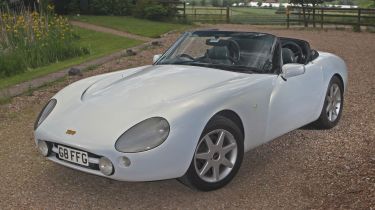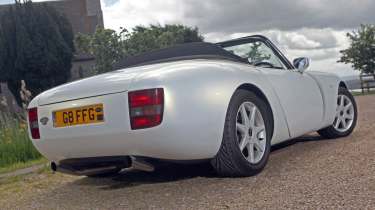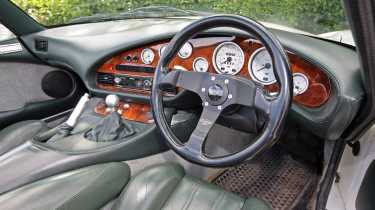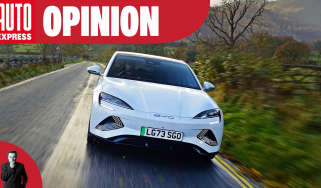Used TVR Griffith (Mk2, 1992-2002) buyer’s guide: a great sports car if you choose with caution
A full used buyer’s guide on the TVR Griffith that was on sale between 1992 and 2002
Verdict
If you’re used to driving a modern high-performance car you’ll have been spoiled with excellent build quality, lots of comfort and safety tech, plus a few safety nets to help you avoid going backwards through a hedge. The TVR Griffith is from another era though, and even the latest examples have no technology to keep you shiny side up, and the build quality can be pretty approximate. But in terms of bang for your buck, the Griffith is pretty much unbeatable, and it comes with an excellent social scene thanks to a large and enthusiastic club. We’d absolutely recommend the Griffith, if you buy and drive it with great care.
There’s been an all-new TVR Griffith on the horizon for the best part of a decade, but the chances of it ever seeing the light of day are diminishing by the month.
If it ever does arrive it will be the third time that TVR has sold a car wearing the Griffith name; the first was in the sixties, and more recently there was a nineties model that we’re covering here. That second-generation Griffith looks great, goes like stink and is relatively affordable to buy – and perhaps best of all, if you get a good one, it needn’t cost a fortune to run. However, it’s easy to get your fingers burned when buying a Griffith, so here’s some advice to make sure that you don’t.
History
TVR showed a Griffith prototype at the 1990 British Motor Show; within a year a completely rejigged production car would make its debut, with a chassis based on that of the Tuscan racer.
Used - available now

2023 Hyundai
i20
43,446 milesManualPetrol1.0L
Cash £10,800
2026 BMW
i4
13,686 milesAutomaticElectric
Cash £27,676
2024 BMW
3 Series
43,114 milesAutomaticPetrol2.0L
Cash £25,197
2022 Citroen
C5 X
41,521 milesAutomaticPetrol1.2L
Cash £13,397By 1992 the first customer cars were being delivered, all powered by a Rover V8 engine. There was a choice of 240bhp 4.0-litre or 280bhp 4.3-litre engines; there were also a handful of 4.5-litre cars, along with some big-valve 4.3-litre models. Griffith production was halted briefly in 1993, then restarted, with only a 340bhp 5.0-litre engine now available.
All Griffiths came with a five-speed manual gearbox, initially a Rover unit, but from 1994 this became a Borg Warner T5 transmission; from 1995 power steering was offered. The final cars were made in 2002, the run-out 500 SE having been launched in 2001. These had a Chimaera dashboard, Cerbera seats and exterior revisions.
Prices
You really have to shop around, because some Griffiths are keenly priced whereas some vendors are very optimistic; there are those who spend plenty on their TVRs then expect to get it all back when they come to sell, so look around before committing to anything.
If you’re handy with the spanners you could buy a viable project for as little as £10,000, but you’re better off spending at least twice this on a 4.0 or 4.3-litre Griffith that’s all together and ready to use, but will need some expenditure before too long.
Unfortunately you can't buy a TVR Griffith through our Find A Car service, but there are plenty of other sports cars available. You can buy a used BMW Z4 for just over £12,000 or even a used Alfa Romeo 4C Spider for just over £46,000.
Check the price of a TVR Griffith with our free car valuation tool...
Which one should I buy?
The most sought after Griffith is the 500 SE, of which 100 were made. So if you’re buying for long-term ownership with one eye on investment, that’s a good bet.
However, there’s always a buyer for a really well looked after Griffith, so anything in really superb condition is a good option; pay less at purchase time and you’re likely to end up spending a fair bit in maintenance over the years.
When these cars were new, many reckoned that the 5.0-litre car had too much power, with the smaller engines plenty quick enough; even the 4.0-litre does 0-60mph in around five seconds, but overall, the 4.3-litre editions offer the best balance of performance and affordability.
All Griffiths came with electric mirrors and windows, and a radio/cassette, but headlamp washers, metallic or pearlescent paint, a tinted windscreen and full leather trim were all extra-cost options.
On the road
With a minimum of 240bhp and a kerbweight of around a ton, scintillating performance is standard whatever the engine. Searing acceleration is yours for the taking, but this is no one-trick pony because perfect weight distribution means excellent agility, while the brakes are very reassuring if in good condition.
The steering is very heavy if there’s no power assistance, but most cars have it; some pre-1995 examples (when it became available) have had it retrofitted.
All in all, the Griffith is great to drive, but in the wet it can be all too easy to run out of talent.
Alternatives to the TVR Griffith
There are few direct rivals. Perhaps the closest is the TVR Chimaera which is a more practical Griffith with a bigger boot and lower purchase prices. It’s similar to drive, but the softer suspension means it’s more comfortable.
A Morgan Plus 8 is even more raw and basic than a Griffith, and comes with a 3.5, 3.9 or 4.6-litre Rover V8. The MG RV8 is also Rover V8-powered and a bit cheaper than a Griffith, but essentially it’s a rehashed MGB, albeit quite a luxurious one. Or you could buy a BMW Z4, Mercedes SLK, Audi TT, Alfa Romeo Spider or similar, all for less money, but they’re far more civilised and also rather less exciting than the TVR.
What to look for
Body shaming
Crash damage is very common, to both the bodywork and the chassis. Even uncrashed cars will probably have scarred paint, and chassis corrosion is also prevalent. If this is major, expect huge bills to put it right.
Engine room
The Rover V8 engine is tough, but oil leaks are the norm and camshafts wear. The coolant hoses perish and exhaust manifold gaskets can fail, leading to blowing. None of these is too costly to fix.
In suspense
The brakes and shock absorbers tend to be long-lived, but the suspension bushes are prone to wear so a fresh set may well be required, and the front wishbones often suffer from corrosion.
All the gears
Transmissions are amazingly durable, with differentials and gearboxes unlikely to give problems unless really badly neglected and if the car has also been very heavily abused.
Interior
TVR was renowned for its outlandish interiors, although the Griffith’s cabin isn’t as crazy as some of the firm’s later cars. Expect creaks and rattles, and the leather may have seen better days, but the seats are very comfortable with space for tall drivers, while the boot is pretty usable for a sports car. And if it isn’t usable enough, just try a Chimaera.
Running costs
There are quite a few really good TVR specialists, but their expertise comes at a price.
All Griffiths need to be serviced every 12 months or 6,000 miles; most owners just have an annual service because few of these cars do many miles each year. Services alternate between Minor (£500) and Major (£800); some specialists charge a bit more and some a bit less. The Major service should include fresh coolant and brake fluid every two years.
Insurance tends to be very reasonable because most Griffiths are insured on a classic car policy, and road tax is manageable because it’s a fixed £360 per year, apart from for the last cars registered after 1 March 2001. These are taxed according to CO2 emissions, which would mean £430 per year, but such cars are few and far between.
Recalls
The only TVR recall on file was issued in August 2001 and it affected 1,534 Cerberas and Tuscans made between December 1996 and May 2001. These left the factory with suspension uprights which could corrode and potentially fail, leading to the suspension collapsing, but this didn’t actually affect the Griffith because it had a different suspension set-up.
With the final Griffith made around a quarter of a century ago, any manufacturing defects will have been fixed by now, so go through any paperwork very carefully to see what’s been replaced. Expenditure is key to keeping a TVR going, and any car that hasn’t had money spent on it regularly (and not been used frequently) is likely to be a financial liability.
Driver Power owner satisfaction
As you’d expect, TVR has never appeared in our surveys because these were niche cars, bought by enthusiasts who know what they’re getting. You don’t go into Griffith ownership on a whim, especially now that these cars have passed into the classic realm. Expect lots of noise, performance and excitement, but sometimes things fall off or stop working, which is why it’s so important to have a great relationship with a highly regarded TVR specialist.
Did you know you can sell your car through Auto Express? We’ll help you get a great price and find a great deal on a new car, too.






